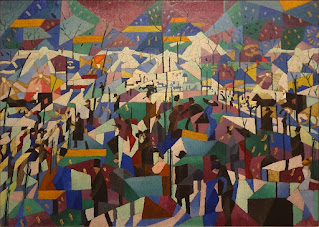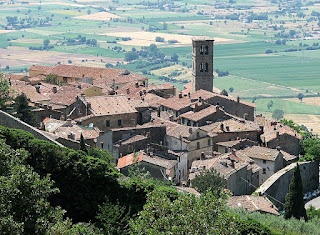Self-taught Venetian became influential figure in 20th century Italian art
 |
| Emilio Vedova was one of the 20th century's most influential artists |
Vedova was known for his expressive abstract paintings, which often had a raw and violent character seemingly inspired by the tumultuous political climate of his time and the apprehension that clouded people’s lives.
A politically engaged figure, in 1942 he joined the Milanese anti-Fascist artists’ association known as Corrente, which included other painters such as Renato Guttuso and Renato Birolli, and fought in the Italian Resistance movement from 1943-45.
After World War Two, he was a co-signatory in 1946 with Corrente member Ennio Morlotti of the Oltre Guernica - Beyond Guernica - manifesto, which encouraged artists to use abstract notions rather than figures to reflect the reality of society. A year later, he founded Fronte Nuovo delle Arti. He described his paintings of this period as Geometrie nere (Black geometries).
Vedova is also associated with the Italian school of Arte Informale, a movement that emerged in various parts of Europe in the mid-1940s, which paralleled the Abstract Expressionism movement in the United States. Both favoured an art based on spontaneous, expressive gestures and a rejection of traditional forms. In Italy, Vedova, Alberto Burri and Lucio Fontana were the most prominent painters in this movement.
Born in Venice into a working-class family, Vedova's father was a house painter. His own first employment - at the age of 11 - was in a factory, after which he was taken on as a photographer’s assistant before finding a position in a restoration workshop.
 |
| Vedova's Image of Time/Barrier (1958) can be seen at the Peggy Guggenheim Collection in Venice |
He went to Florence to attend a free school of nude painting, mixing with other artists and artisans in the San Frediano district. It was there he made his first contacts within anti-Fascist circles.
Returning to Venice, he struggled to make ends meet but with the help of the Opera Bevilacqua La Masa, which supported poor artists, managed to obtain an attic-studio in Palazzo Carminati. His first paintings on public view - mainly nudes and still lifes - were exhibited at the Galleria Ongania in Venice in 1940.
Appalled at the direction in which Italy was travelling under Mussolini, his attraction to the Corrente group in Milan was that he saw it as a counterpoint to the Novecento and Italian Futurism schools, both of which were regarded as nationalistic and pro-Fascist.
 |
| As a young painter, Vedova was fortunate to be provided with a studio by a charitable organisation |
Given his own passionate opposition to Fascism, it was no surprise that he was drawn to the Resistance movement. He took part in activities in Rome and in the hills around Belluno in the Veneto, where he was wounded.
When peace returned, he began to create pastels in which he expressed his state of mind as it was shaped by the experience of war. In 1948 he participated for the first time in the Venice Biennale. By 1952, his work was seen as important enough to have a room at the exhibition entirely dedicated to him.
In 1951, Vedova exhibited his first solo show in the United States at the Catherine Viviano Gallery in New York, where he began to be noticed by high-profile collectors such as Peggy Guggenheim. He received a Guggenheim International award in 1956 and the Grand Prize for Painting at the 1960 Venice Biennale.
As appreciation for his work spread, he spent time abroad, including spells in Brazil, Japan, the United States, Mexico and Berlin. Back in Italy, the student revolts of the late 1960s and the instability of the so-called Years of Lead in the 1970s and ‘80s, informed his work in the same way as his wartime experience earlier.
Vedova was a restlessly inventive artist throughout his career. He collaborated with the avant-garde composer Luigi Nono, designing sets and costumes for the opera Intolleranza in 1960, and a light setting for Nono's opera Prometeo at La Fenice in 1984.
He designed large-scale glass engravings, as well as numerous plurimi - freestanding, multi-panelled painted sculptures made of wood and metal. In 1993 the Accademia dei Lincei awarded him the Feltrinelli Prize for painting, and in 1997 he received the Golden Lion for his work at the Venice Biennale.
His work began to find a permanent place in gallery and museum exhibitions at the Galleria Nazionale d'Arte Moderna in Rome and the Peggy Guggenheim Collection in Venice among others.
He kept a permanent home in Venice for much of his life and between 1975 and 1986 taught the city’s Accademia di Belle Arti. He died in Venice in 2006 at the age of 87. He is buried in the monumental cemetery of San Michele, on an island in the lagoon.
Travel tip:
An example of the studio spaces on offer to
selected young artists at Palazzo Carminati
The Palazzo Carminati, where Emilio Vedova had his first studio, is in the Santa Croce sestiere of Venice. Recently restored, in addition to offering a wonderful view of the city, the top floor of the historic building also houses seven studios for selected young artists under the auspices of the Bevilacqua La Masa foundation, and two guest houses reserved for residency programmes. It can be accessed from the San Stae vaporetto stop by walking approximately 230m along Salizada San Stae and turning right into Ramo Carminati.
Travel tip:.jpg)
The Peggy Guggenheim Collection is kept
at the Palazzo Venier dei Leoni in Venice
Peggy Guggenheim died in 1979 but her legacy to Venice remains in the collection of modern art she accumulated, much of which is on display at the Peggy Guggenheim Collection, a museum located in the 18th century Palazzo Venier dei Leoni, on the Grand Canal in the Dorsoduro district, where the American heiress lived for three decades. Open to the public from 10am to 6pm, the Peggy Guggenheim Collection is home to the works of many prominent painters. Two works by Emilio Vedova acquired by her in the 1950s remain in the collection: Image of Time/Barrier (1958) and Hostage City (1954). More recently, Vedova's monotype Opposite Space IV (2006) was donated to the Collection by the Emilio and Annabianca Vedova Foundation.
Also on this day:
1173: Work begins on the campanile later famous as the Leaning Tower of Pisa
1939: The birth of politician Romano Prodi
1973: The birth of footballer and coach Filippo Inzaghi
.jpeg)










